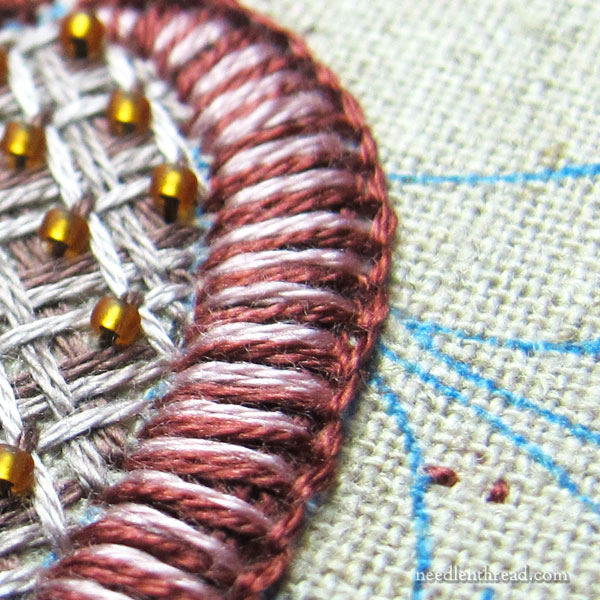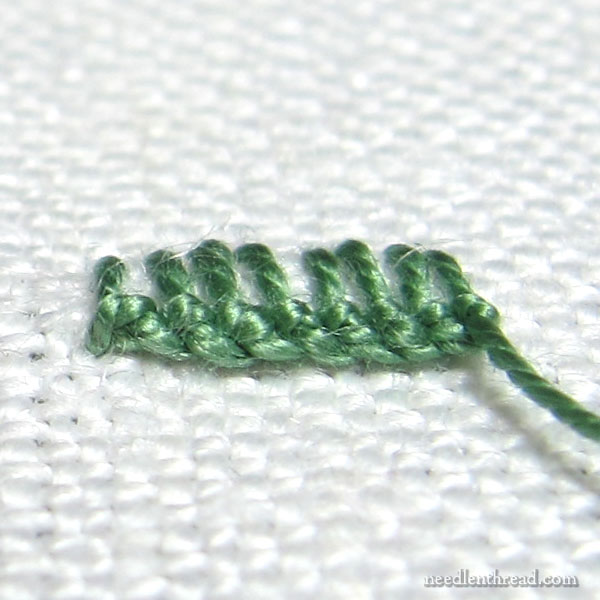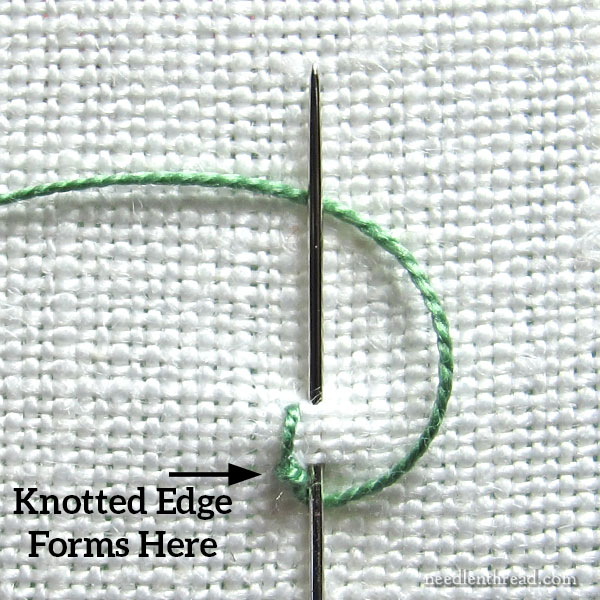The buttonhole stitch is a super-versatile embroidery stitch. Perhaps because it isn’t a skinny line stitch and it isn’t a typical filling stitch, it doesn’t always get the attention it deserves.
But one area where the buttonhole stitch seems to garner some scrutiny is in a question of semantics – that is, in the area of definition or meaning.
I’ve recently heard from a few stitchers – some of them new to embroidery – who are a little confused about whether or not the stitch we call the buttonhole stitch really is the buttonhole stitch.
The question is basically this: Is buttonhole stitch, as it is most commonly known, actually the blanket stitch, while “true” buttonhole stitch is a completely different stitch altogether?
Every time I write about buttonhole stitch, I get a few emails with questions like this. I’ve heard from stitchers full of good intentions, encouraging me to be careful of causing confusion by calling the buttonhole stitch the buttonhole stitch. And I’ve heard from stitchers on a buttonhole crusade, who harshly reprimand – “you should know better” and “shame on you” for perpetuating this heinous misnomer.
Let’s chat about the stitch, discuss the name debate, and examine some clarifications and historical references, so that we can clear up any confusion over what’s what with the buttonhole stitch!

The photo above is a flower embroidered with buttonhole stitch, worked close together. The petals are filled with a layer of buttonhole stitch on the outside edge extending inward, and, on the inside, the “spikes” of the buttonhole stitch are split with straight stitches (with the same approach you’d take with long & short stitch shading), to shade the petal. The buttonhole stitch gives the outline of the petal a distinct, twisted edge.
You see that buttonhole stitch can be used quite well as a filling, especially if you want a twisted, neat edge on the design line.

The leaves in the photo above are also worked in buttonhole stitch (you can find the tutorial for buttonhole stitch leaves like these – with little flowers – here).
The stitches are spaced a little farther apart, to give the sense of leaf veins and some shaping to the leaves, and you can see the characteristic twist on the edge of the leaves, that define the design outline.

In the photo above, buttonhole stitch is worked over a padded filling, with the stitches (in the brick red) spaced about one stitch width apart. Once the buttonhole stitching is complete, the lighter stitches (just simple straight stitches) are worked between the buttonhole stitches, to create a striped effect.
So we can see that buttonhole stitch can be used effectively as a filling, to create a whole motif (like a leaf), or as a band stitch, in different ways. And there are many, many more ways that you can use buttonhole stitch and its variations in needlework. You can find lots of examples in my Stitch Fun! series.
But the Name Debate
Those who debate the name of the stitch usually assert that the stitch illustrated in the photos above is not buttonhole stitch, but rather, blanket stitch.
It’s true that the two stitches – buttonhole stitch and blanket stitch – are formed exactly the same way, but, historically, there is a slight distinction between the two stitches.
Most people who bring up the subject tend to think that the distinction is that “true” buttonhole stitch has a knotted edge to it – that in fact, the stitch we call buttonhole stitch is not buttonhole stitch at all, but blanket stitch, and that a “true” buttonhole stitch has a knotted edge.
But this, historically, is not the distinction between buttonhole stitch and blanket stitch. The distinction, if one is going to be made, is where the stitch is worked, not how the stitch is worked.
Will the Real Buttonhole Stitch Please Step Forward?
Buttonhole stitch as we commonly know it and call it – without any kind of extra knotting along the line – is really just buttonhole stitch.
Whether it is stitched on an edge of fabric, whether spaced farther apart, it is still buttonhole stitch, although, as many authors note, when worked on the edge of fabric to secure it, it is sometimes called blanket stitch. I’ll clarify this below.
What most name debaters assert is “true” buttonhole stitch is this stitch:

If you look closely at the edge of the line there, you can see an extra loop or knot along the edge.
Tailor’s Buttonhole
This stitch, with the knotted edge, is the tailor’s buttonhole. The knotted edge gives a little more stability when the stitch is worked over the edge of fabrics to form (for example) button holes on coats and the like.
Tailor’s buttonhole isn’t a very well known stitch nor widely used, because plain old buttonhole stitch for most surface and decorative embroidery does the edge job just fine.
So whether you’re using buttonhole stitch in cutwork, in Hardanger, in regular surface work, in whitework, in crazy quilting – the plain twisted edge does what it’s supposed to do. The extra knotted edge ends up being merely decorative in most applications, and in fact, with some threads, the extra knotting can throw off the neat spacing that comes with buttonhole stitch.
Tailor’s Buttonhole – Different Stitch Movement
But the distinction goes further, because the tailor’s buttonhole stitch is not the buttonhole stitch. It is formed differently.
To work the tailor’s buttonhole easily, neatly, and consistently, the least complex way of doing it is actually a completely different stitch movement, compared to the buttonhole stitch.
Buttonhole stitch is formed this way: the needle comes up on the design line where the twisted edge will develop. It passes to the back of the fabric above the design line (where the tips of the “spikes” of the buttonhole would be), and emerges back on the design line next to where the stitch started and over the working thread. Pull the thread through, and that’s a buttonhole stitch. (If you’re not familiar with it, you can find a video for buttonhole stitch here.)
With tailor’s buttonhole, if you want to work it in the easiest way possible, the movement is the opposite – the needle goes down into the fabric where the twisted edge develops (on the design line) and comes up into the fabric at the tip of the spikes.
Additionally, the working thread passes behind the eye of the needle and behind the tip of the needle, in order for the knot to form on the edge. When the thread is pulled through and upwards away from the design line, the thread tightens, and then the stitch is finished by pulling the thread towards you (down towards the design line), situating the knotted edge on the design line.
Here’s what the set-up for a tailor’s buttonhole looks like, if you want to work it in the quickest and easiest way:

You can see that the working thread is behind the eye-end of the needle and behind the tip-end of the needle, and that the needle is pointing upwards, away from the edge formed by the stitch.
In some stitch dictionaries, tailor’s buttonhole is illustrated similarly to the buttonhole, only with an extra twisted loop over the tip of the needle. This method of forming the stitch doesn’t work up as quickly as the method illustrated above, and it’s not as easy to situate the knotted edge neatly and consistently.
Historically Speaking
You don’t see “blanket stitch” illustrated often in too many older stitch dictionaries. When you do find a reference to it, it’s usually as an aside, and not as its own classification or type of stitch. It is always mentioned in association with the buttonhole stitch, as we will see below.
Blanket stitch and buttonhole stitch are the same stitch, technically. They are formed exactly the same way.
The tailor’s buttonhole stitch is a completely different stitch altogether, as it is formed differently, and in no historical reference do we see “buttonhole stitch” illustrated with an extra knot. But we do see “tailor’s buttonhole” illustrated, separately from buttonhole stitch.
Lewis & Buckle on Buttonhole Stitch
In 1900, you’ll find buttonhole stitch (as we know it) elaborately detailed in Art in Needlework by Lewis Day and Mary Buckle, on page 56. When writing about buttonhole stitch (and mentioning blanket stitch), the authors state:
One need hardly describe Buttonhole Stitch. The simple form of it is worked (when you have brought your needle out) keeping the thread under your thumb to the right, whilst you put the needle in again at a higher point slightly to the right, and bring it out immediately below, close to where it came out before. This and other one-edged stitches of the kind are sometimes called “blanket stitch.”
Grace Christie on Buttonhole Stitch
In 1912, you’ll find the buttonhole stitch, illustrated in chapter five of Grace Christie’s book, Embroidery and Tapestry Weaving, where she makes the clear distinction between buttonhole stitch (which she refers to as the “common buttonhole stitch”) and tailor’s buttonhole stitch (with the knotted edge). In this book, the author indicates that buttonhole stitch…
is very useful also in embroidery… Owing to its construction, it is well-suited for the covering of raw edges, but it is also adaptable to a variety of other purposes such as are open or close fillings of leaves and flowers, cut work, and the outlining of applied work.
She then goes on to describe two distinct stitches: “There are two ways of forming the stitch, the common buttonhole and what is called tailor’s buttonhole.” Tailor’s buttonhole has the knotted edge.
But notice that in Christie’s description, she never uses the term “blanket stitch,” even though she talks about securing the edge.
In Christie’s book, the only reference to “blanket stitch” is actually to a completely different stitch altogether that’s used as a kind of pulled thread stitch and looks more like Algerian eye or something similar.
L. Higgins on Blanket Stitch
If we go back as far as 1880, you’ll find something very interesting in the Handbook of Embroidery by L. Higgins, published by authority of the Royal School of Art-Needlework. In this book, you actually find the “blanket stitch” illustrated and called “blanket stitch” – but notice the description:
Blanket Stitch is used for working the edges of table-covers, mantel valances, blankets, &c., or for edging any other material. It is simply a button-hole stitch [emphasis mine], and may be varied in many ways by sloping the stitches alternately to right and left; by working two or three together, and leaving a space between them and the next set; or by working a second row round the edge of the cloth over the first with a different shade of wool.
Higgins assumes the stitcher knows the buttonhole stitch. The distinction is that the blanket stitch is a buttonhole stitch used to edge. But nowhere in the entire book does the author illustrate how to work the buttonhole stitch. It is just assumed the stitcher knows how to work it, I presume because it was such a commonly known stitch, and known by the name of buttonhole stitch.
Higgins makes no mention of a buttonhole stitch that forms a knotted line at the base.
Mary Thomas on Buttonhole, Tailor’s Buttonhole, and Blanket Stitch
In Mary Thomas’s Embroidery Book (1935), which contains cross-references to her stitch dictionary, two sections of the book give insight to her use of the term “buttonhole stitch” and “tailor’s buttonhole.” The first is the section on Broderie Anglais, a form of whitework coupled with cutwork, in which buttonhole stitch plays a primary role in edging the areas that are cut away from the ground fabric.
In this section, Mary Thomas illustrates the buttonhole stitch as the buttonhole stitch as we know it.
In the back of the book, Thomas talks about tailor’s buttonhole, literally from the point of view of a tailor making a coat. The stitch illustrated in this section is the tailor’s buttonhole worked as I’ve illustrated above. The point is that she doesn’t call this stitch, which forms the knotted edge, “buttonhole stitch,” but rather “tailor’s buttonhole.”
In the reprint edition of Thomas’s stitch dictionary edited by Jan Eaton and published in 1998, the blanket stitch is explained thus:
Blanket Stitch: (Also known as open buttonhole stitch.) Blanket stitch is worked in the same way as buttonhole stitch… The only difference between them lies in the spacing of the stitches. Blanket stitch is used as an edging stitch for appliqué and as a surface stitch. The name probably devices from its traditional use as a finish for the edges of blankets….
Here, we see a stated distinction between buttonhole stitch and blanket stitch, based on spacing. While Higgins (in Handbook of Embroidery) classifies blanket stitch as a stitch used for edging, she doesn’t actually distinguish it from buttonhole based on spacing, but rather based on use.
In Thomas’s dictionary, tailor’s buttonhole is described as
…similar to ordinary buttonhole stitch…but it makes a strong, hardwearing edge which is particularly suitable for use on heavyweight fabric. Use it to finish raw edges and as a border stitch on either plain- or even-weave fabric.
Interestingly, the tailor’s buttonhole as illustrated in the reprint edition (1998) of Thomas’s stitch dictionary, is not the same as the tailor’s buttonhole illustrated in Mary Thomas’s Embroidery Book. Instead, the illustration is similar to Christie’s, except for the way the working thread overlaps itself on the loops for the set-up of the stitch.
Neither Christie’s nor Thomas’s approach is as quick as the set-up shown above for the tailor’s buttonhole, nor does it guarantee an easy, accurate placement for the knotted line. Eventually, they achieve a similar outcome, but the way I’ve illustrated it above – and the way Mary Thomas originally illustrates it in her Embroidery Book – is faster, easier, and more consistent in the placement of the knotted edge.
All that being said, the take-away from Thomas’s books is that tailor’s buttonhole is not buttonhole. But blanket stitch and buttonhole are technically the same stitch, distinguished by spacing.
In a Nutshell
So if you’re ever talking about the buttonhole stitch and the argument comes up that buttonhole stitch is really blanket stitch and that “proper” buttonhole stitch has a knotted edge to it, these are the points to keep in mind:
1. Buttonhole stitch, as we know it, has been around for a long time, and is called “buttonhole stitch” in significant historic needlework books.
2. In the commonly accessible embroidery books of old, and in most embroidery books today, buttonhole stitch is not illustrated with a knotted edge. If a knotted edge is involved, the distinction of names is always present – the knotted edge version is referred to as tailor’s buttonhole.
3. Buttonhole stitch and what is called “blanket stitch” are the same stitch. Blanket stitch usually implies that it’s worked on the edge of something, to secure the edge, and sometimes it implies that the stitches are spaced further apart. But even when worked over an edge, it can still be called buttonhole stitch, and the term used this way would not be incorrect, since the distinctions are distinctions of accident (spacing and place) rather than distinctions in form (they are the same stitch).
4. Tailor’s buttonhole, which forms a knotted edge, is a completely different stitch, producing a completely different result with a completely different stitch movement – either because it is worked in the manner shown above, or because it involves one more twisted loop on the needle before pulling the stitch through. It is distinguished from buttonhole stitch by its knotted edge and the different stitch movement to achieve that knotted edge. And in every well-known stitch dictionary, it is distinguished by its name: “tailor’s buttonhole.”
So What?
You’re right! It really doesn’t make that much of a difference. In either case, when it comes to blanket or buttonhole stitch, the stitch itself is exactly the same, and it doesn’t really matter what it’s called.
However, when it comes to implying that the “true” buttonhole stitch forms a knotted edge, this is actually incorrect, and advancing this notion will simply cause confusion, especially to newbies.
Questions? Comments? Suggestions? If you want to weigh in on the name debate, or you have any questions or comments on it, feel free to have your say below!